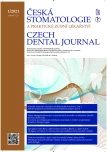MANDIBULAR FRACTURES AND THEIR RELATION TO FACIAL SKELETON TRAUMA AND CERVICAL SPINE DAMAGE
Original article – retrospective study
Authors:
M. Mozoľa; P. Tvrdý; P. Michl; P. Heinz; R. Pink
Authors‘ workplace:
Klinika ústní, čelistní a obličejové chirurgie, Lékařská fakulta Univerzity Palackého, a Fakultní nemocnice, Olomouc
Published in:
Česká stomatologie / Praktické zubní lékařství, ročník 121, 2021, 1, s. 28-32
Category:
Original articles
Overview
Aim: The study was focused on the evaluation of etiological factors of mandibular fractures, their frequency, relationship to the season and the relationship with head and neck skeletal injuries.
Methodology: A retrospective study of lower jaw injuries was performed at the Department of Oral and Maxillofacial Surgery at the Olomouc University Hospital in the period from 01. 01. 2013 to 31. 12. 2017. 432 patients with radiographically verified mandibular fracture were reported. The classification of fractures was governed by the AOCMF classification system. The season in which the injury occurred, the mechanism of the injury, and whether other structures of the skeleton of the face and neck were injured were monitored.
Results: Out of a total of 432 patients, 250 simple fractures were diagnosed. In 182 cases it was a multiple fracture and in 77 cases other structures of the skeleton of the head and neck were injured. The most common cause was evaluated 143 attacks (33.10%), followed by falls, cyclist injuries and traffic accidents. The maximum of mandibular fractures was recorded in July (50 patients).
Keywords:
mandible fractures – facial skeleton trauma – cervical spine damage
Sources
1. Pazdera J. a kol. Základy ústní a čelistní traumatologie. Univerzita Palackého v Olomouci: 2017, 182.
2. Cornelius CP, Audige L, Kunz C, Rudderman R, Buitrago-Tellez C, Frodel J, Prein J. The Comprehensive AOCMF Classification System: mandible fractures – level 2 tutorial. Craniomaxillofac Trauma Reconstr. 2014; 7(Suppl 1): S015–S030.
3. Boffano P, Kommers SC, Karagozoglu KH, Gallesio C, Forouzanfar T. Mandibular trauma: a two-centre study. Int J Oral Maxillofac Surg. 2015; 44(8): 998–1004.
4. Ramadhan A, Gavelin P, Hirsch JM, Sand LP. A retrospective study of patients with mandibular fractures treated at a Swedish University Hospital 1999–2008. Ann Maxillofac Surg. 2014; 4(2): 178–181.
5. Oikarinen K, Schutz P, Thalib L, Sandor GK, Clokie C, Meisami T, Safar S, Moilanen M, Belal M. Differences in the etiology of mandibular fractures in Kuwait, Canada, and Finland. Dent Traumatol. 2004; 20(5): 241–245.
6. de Matos FP, Arnez MF, Sverzut CE, Trivellato AE. A retrospective study of mandibular fracture in a 40-month period. Int J Oral Maxillofac Surg. 2010; 39(1): 10–15.
7. Subhashraj K, Ramkumar S, Ravindran C. Pattern of mandibular fractures in Chennai, India. Br J Oral Maxillofac Surg. 2008; 46(2): 126–127.
8. Malik S, Singh G, Kaur G, Yadav S, Mittal HC. Orofacial trauma in rural India: A clinical study. Chin J Traumatol. 2017; 20(4): 216–221.
9. Svensson J, Landberg J. Is youth violence temporally related to alcohol? A time-series analysis of binge drinking, youth violence and total alcohol consumption in Sweden. Alcohol Alcohol. 2013; 48(5): 598–604.
10. Imai T, Sukegawa S, Kanno T, Fujita G, Yamamoto N, Furuki Y, Michizawa M. Mandibular fracture patterns consistent with posterior maxillary fractures involving the posterior maxillary sinus, pterygoid plate or both: CT characteristics. Dentomaxillofac Radiol. 2014; 43(2): 20130355.
11. Blatt S, Rahimi-Nedjat R, Sagheb K, Piechowiak L, Walter C, Brullmann D. Coincidence of mandibular fractures with isolated posterior maxillary sinus fractures. Dent Traumatol. 2017; 33(5): 345–349.
12. Ali IK, Sansare K, Karjodkar FR, Salve P, Vanga K, Pawar AM. Maxillofacial trauma patterns associated with external auditory canal fractures: Cone beam computed tomography analysis. Dent Traumatol. 2017; 33(4): 276–280.
13. Elahi MM, Brar MS, Ahmed N, Howley DB, Nishtar S, Mahoney JL. Cervical spine injury in association with craniomaxillofacial fractures. Plast Reconstr Surg. 2008; 121(1): 201–208.
14. Mourouzis C, Schoinohoriti O, Krasadakis C, Rallis G. Cervical spine fractures associated with maxillofacial trauma: A 3-year-long study in the Greek population. J Craniomaxillofac Surg. 2018; 46(10): 1712–1718.
15. Reich W, Surov A, Eckert AW. Maxillofacial trauma – Underestimation of cervical spine injury. J Craniomaxillofac Surg. 2016; 44(9): 1469–1478.
16. Lalani Z, Bonanthaya KM. Cervical spine injury in maxillofacial trauma. Br J Oral Maxillofac Surg. 1997; 35(4): 243–245.
17. Hills MW, Deane SA. Head injury and facial injury: is there an increased risk of cervical spine injury? J Trauma. 1993; 34(4): 549–553; discussion: 53–54.
Labels
Maxillofacial surgery Orthodontics Dental medicineArticle was published in
Czech Dental Journal

2021 Issue 1
Most read in this issue
-
MANDIBULAR FRACTURES AND THEIR RELATION TO FACIAL SKELETON TRAUMA AND CERVICAL SPINE DAMAGE
Original article – retrospective study - SELECTED PROPERTIES OF CONTEMPORARY ENDODONTIC SEALERS: PART 2
-
VÝSKYT NEDIAGNOSTIKOVANÝCH ORTODONTICKÝCH ANOMÁLIÍ NA ZÁKLADNÍCH ŠKOLÁCH OLOMOUCKÉHO KRAJE
Původní práce – epidemiologická studie -
CARIOGENIC MICROFLORA IN CHILDREN WITH EARLY CHILDHOOD CARIES AND THEIR MOTHERS
Original article – clinical study
